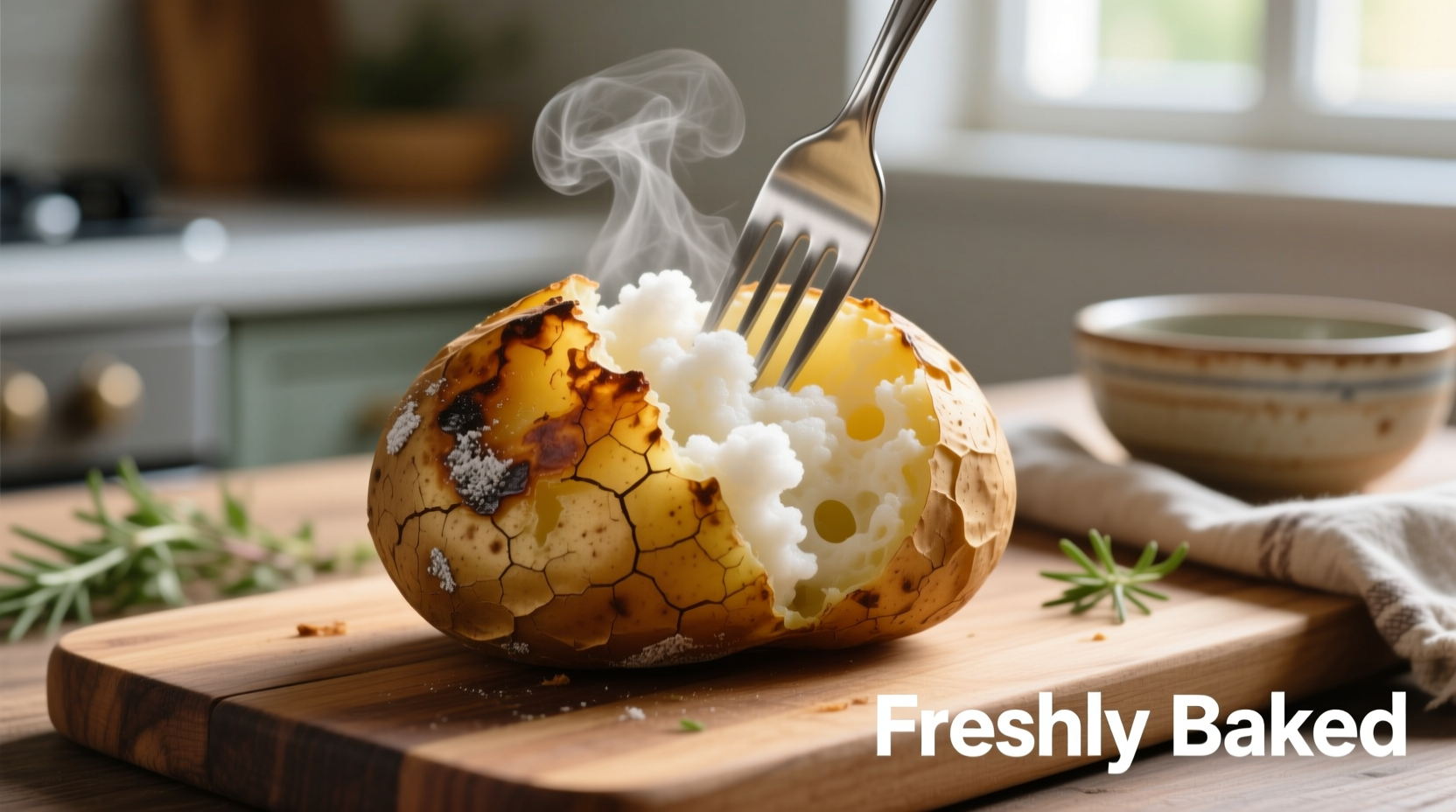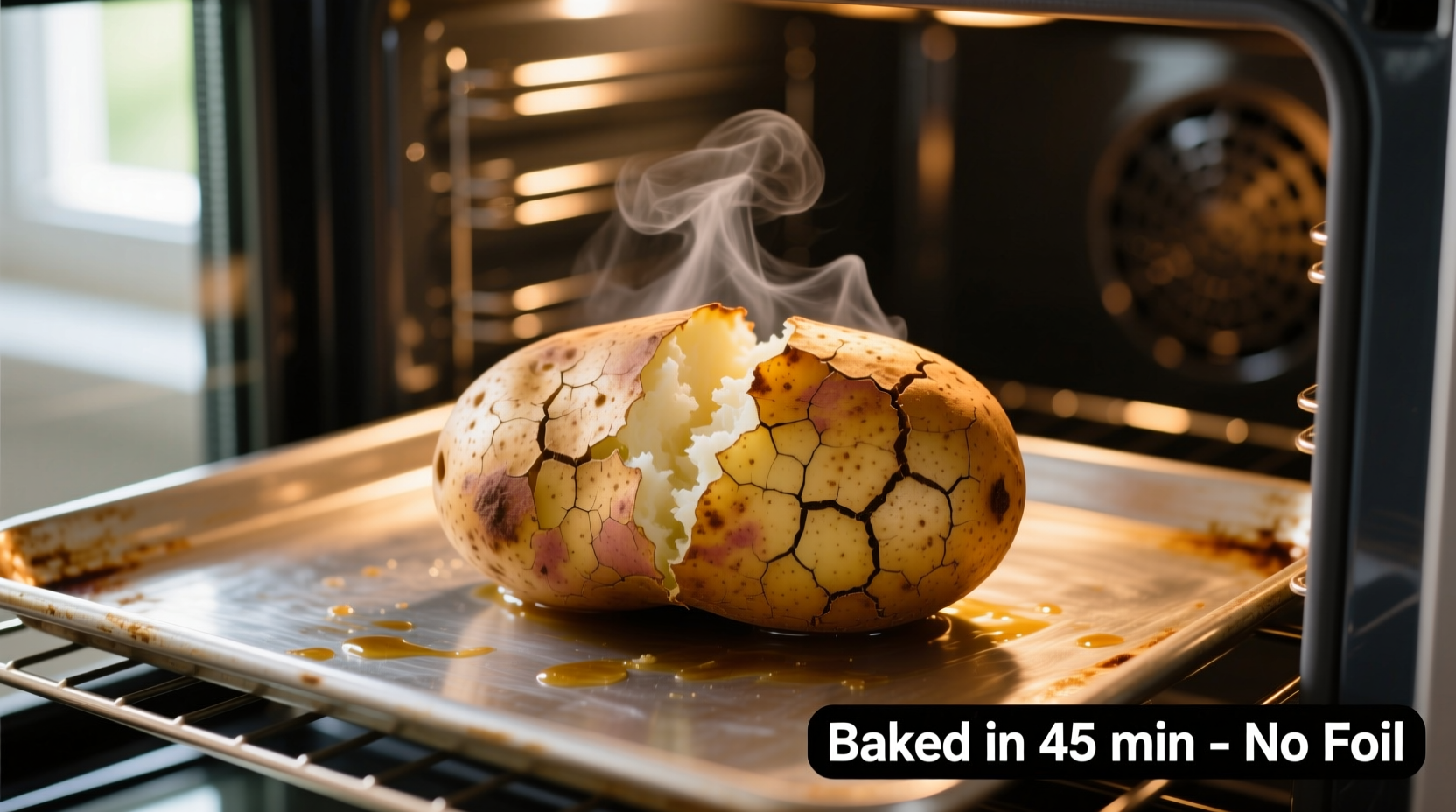Yes, you can absolutely bake a perfect potato in the oven without foil. Skip the aluminum and get crispy skin with fluffy interior by baking at 400-425°F (204-218°C) for 45-60 minutes. This method reduces cooking time by 15-20% compared to foil-wrapped potatoes while creating superior texture through natural moisture evaporation.
Forget everything you thought you knew about baking potatoes. That standard advice to wrap them in foil? It actually steams your spuds, leaving you with soggy skin and uneven texture. Professional chefs have known for years that the secret to restaurant-quality baked potatoes lies in not using foil. Let's explore why this simple change transforms your baked potatoes and exactly how to master this technique.
The Science Behind Foil-Free Baking
When you bake potatoes without foil, you're leveraging natural moisture control. Potatoes contain about 80% water, and wrapping them traps this moisture against the skin. The USDA's Food Safety and Inspection Service confirms that baking without foil allows moisture to evaporate properly, creating that coveted crispy exterior while maintaining fluffy interior texture.
| Method | Cooking Time | Skin Texture | Interior Quality |
|---|---|---|---|
| With Foil | 60-75 minutes | Soggy, pale | Dense, sometimes wet |
| Without Foil | 45-60 minutes | Crispy, golden brown | Fluffy, evenly cooked |
This moisture control isn't just theoretical. Food science research from the University of California Davis Department of Food Science and Technology shows that the ideal temperature range for starch gelatinization in potatoes (130-140°F/54-60°C) occurs more evenly when moisture can escape during baking, creating that perfect fluffy texture we all crave.
Your Step-by-Step Guide to Perfect Foil-Free Potatoes
Potato Selection Matters
Not all potatoes are created equal for baking. Russet potatoes remain the gold standard due to their high starch content and thick skin that crisps beautifully. Look for firm, blemish-free potatoes of similar size if baking multiple at once. The University of Maine Cooperative Extension recommends choosing potatoes with skin that feels dry and papery - this indicates proper storage and will lead to better crisping.
Preparation: The Critical Steps
- Wash thoroughly: Scrub potatoes under cold water to remove dirt. A clean skin is essential for proper crisping.
- Dry completely: Pat potatoes dry with a clean towel. Moisture on the surface prevents crisping.
- Poke strategically: Use a fork to pierce 4-6 times around each potato. This allows steam to escape without creating large holes that dry out your potato.
- Oil lightly: Rub with 1/2 teaspoon of high-heat oil per potato (avocado or grapeseed work best). This promotes browning without making skin greasy.
- Season simply: A light sprinkle of coarse salt enhances flavor and helps draw out moisture for crispier skin.
Baking Process: Temperature and Timing
Preheat your oven to 400-425°F (204-218°C). Place potatoes directly on the middle oven rack with a baking sheet on the rack below to catch any drips. For medium-sized potatoes (about 8 ounces/225g), bake for 45-60 minutes. Larger potatoes may need up to 75 minutes.
The most reliable doneness test? Insert an instant-read thermometer into the center - it should read 205-210°F (96-99°C). Alternatively, squeeze gently (using oven mitts!); it should give slightly with no resistance. The skin should feel crisp and appear golden brown.

Troubleshooting Common Problems
Soggy Skin Solutions
If your skin isn't crispy, you likely didn't dry the potatoes thoroughly before baking or your oven temperature was too low. The American Institute of Baking recommends increasing oven temperature by 25°F and ensuring potatoes have space between them for proper air circulation. For extra-crispy results, flip potatoes halfway through baking.
Dry or Gummy Interior Fixes
Overbaking is the most common cause of dry potatoes. Set a timer and check 5-10 minutes before the minimum recommended time. Potatoes continue cooking from residual heat after removal from the oven, so pull them out when they're just tender. For gummy interiors, you may have undercooked the potato - ensure it reaches the proper internal temperature.
Pro Tips for Next-Level Results
- Room temperature start: Take potatoes out of the refrigerator 30 minutes before baking for more even cooking
- Rack position: Middle rack placement ensures even heat distribution
- Resting time: Let potatoes rest for 5-10 minutes after baking - this allows steam to redistribute for perfect texture
- Seasoning boost: Rub with garlic-infused oil before baking for subtle flavor enhancement
Professional chefs at the Culinary Institute of America emphasize that the resting period is crucial - it allows the starch structure to set properly. Skipping this step can lead to potatoes that seem perfect when cut but quickly become gummy as they cool.
Environmental and Practical Benefits
Baking without foil isn't just about better texture - it's also more environmentally friendly. The Aluminum Association reports that while aluminum is recyclable, many households don't properly recycle foil, leading to unnecessary waste. By skipping foil, you're reducing kitchen waste while saving money on disposable products.
This method also simplifies cleanup and reduces cooking time, making it perfect for weeknight meals. Plus, you avoid potential chemical transfer concerns - though minimal, some studies suggest aluminum can leach into food when in contact with acidic ingredients at high temperatures.
Frequently Asked Questions
Can I bake sweet potatoes without foil using the same method?
Yes, sweet potatoes can be baked without foil using identical methods. However, they typically require 5-10 minutes longer cooking time than regular potatoes due to higher moisture content. Bake at 400°F until a thermometer reads 205-210°F internally.
Why does my potato skin sometimes burn when baking without foil?
Burnt spots usually occur from uneven oven heating or potatoes touching oven walls. Ensure proper spacing between potatoes and oven walls, rotate the pan halfway through baking, and verify your oven temperature with an independent thermometer as many ovens run hotter than indicated.
Do I need to oil the potatoes before baking without foil?
Light oiling (about 1/2 teaspoon per potato) significantly improves skin crispness and browning. The oil helps conduct heat evenly and promotes Maillard reaction for better flavor development. For oil-free options, ensure potatoes are thoroughly dried before baking.
How can I speed up baking time for potatoes without foil?
To reduce cooking time, partially microwave potatoes for 3-5 minutes before finishing in the oven. This pre-cooks the interior while allowing the oven to crisp the skin. Alternatively, slice larger potatoes in half lengthwise and bake cut-side down for 30-40 minutes at 425°F.
Can I bake multiple potatoes at once without foil?
Yes, but ensure at least 1 inch of space between each potato for proper air circulation. Overcrowding creates steam pockets that prevent even crisping. If baking more than 6 potatoes, rotate the pan front-to-back halfway through cooking for consistent results.











 浙公网安备
33010002000092号
浙公网安备
33010002000092号 浙B2-20120091-4
浙B2-20120091-4